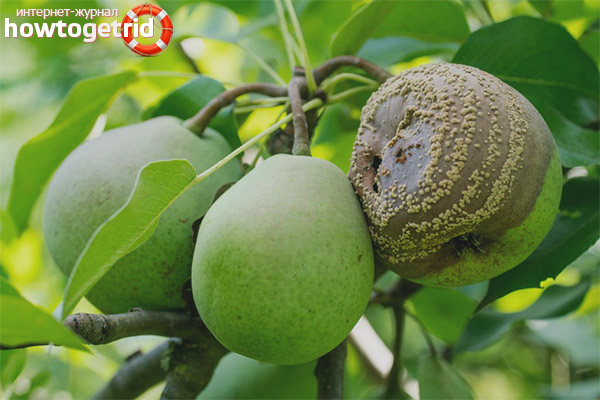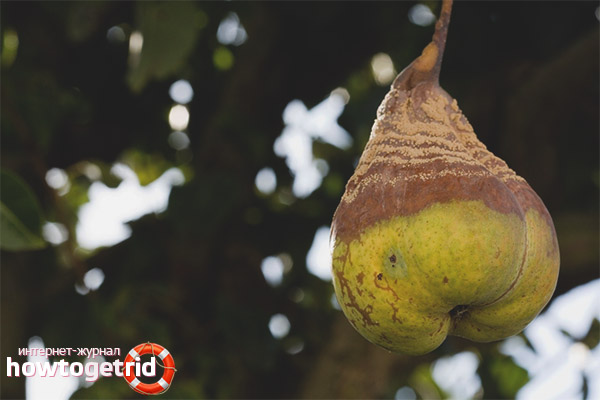The content of the article
Each gardener diligently cares for their trees to get a generous harvest. However, no one is safe from diseases and pests, which sometimes attack fruit crops. What to do if the pear began to bear spoiled fruit or an infection started on a tree? Read more about the dangers in the garden, and how to cure pear trees.
Why do pear fruits deteriorate
Sometimes gardeners notice that the harvest has not become as tasty and appetizing as before. This is manifested by different symptoms - the fruits have become rough, unsweetened, watery, rot or they were struck by caterpillars. The good news is that all these troubles can be overcome. And if you have not put up with the low quality of the crop, try to prevent the garden - and perhaps your fruit crops will surprise you with a fragrant product. The most common causes of fruit tree diseases are:
- Bad weather: frosts, heavy rains and cold winds affect the condition of the tree - the integrity of its bark, the abundance of young shoots, flowers and ovaries, as well as the quality of the fruit.
- Insect pests. The pear is most attacked by the moth and weevil. These parasites not only eat whole juicy fruits that lose their ability to be stored for a long time, but also infect the crop with larvae and caterpillars that develop in a nutrient medium.
- Fungal diseases. Among them, an almost harmless external fungus, scab, is most often found. Because of it, growths form on the skin of the fruit. You can also find a fungus that develops inside the fruit, causing them to ferment and rot on the branches.
- Old age of the tree. With age, the fruit tree degenerates, which causes the fruits to rot.
Let's consider all the reasons in more detail, and most importantly, we will tell you how to deal with them in order to defend fragrant rich crops.
How bad weather hurts a tree
Every spring it is necessary to prune the branches so that new fresh shoots can hatch. Thanks to this, the tree is rejuvenated and brings a quality crop. In the fall, pruning cannot be done, otherwise the exposed sections of the bark may freeze, and the tree will deteriorate from the inside. During the awakening of the garden, frost-bitten and damaged branches are removed, forming a uniform crown filling.
What are dangerous insect pests for orchard
Codling moth is a garden moth attacking pears, apple trees, peaches and other fruit trees throughout the summer. It is she who is one of the most frequent threats. This moth spoils the integrity of the fruit, leaving inside its caterpillars that develop in the garden and boldly migrate from tree to tree. The weevil beetle trades in the spring and summer, spoiling not only the fruits, but also the buds, color and young foliage. This parasite punctures the fruits, making a hole in them, and leaves its faces to develop in a sweet environment, after which it attacks the following trees.
The danger of these pests is not only in their high numbers, but also in the fact that such an infection is potentially harmful to the entire garden. When the spoiled fruits fall, the caterpillars leave them and move to a new, juicy “house”.
To protect the garden he insect raid, apply several methods:
- Fallen fruits are carefully harvested from the ground throughout the summer and autumn to avoid pest migration.
- Illuminated traps are set in the garden, because, as you know, butterflies fly to bright lanterns. Tanks with kerosene or soapy water are located next to the lamps. Also, the codling moth is attracted by apple syrup or serum, hanging traps directly on the branches.
- Sticky tree wraps also help: the trunk is wrapped with rags or thick paper and impregnated with solid oil, non-curing glue. Caterpillars, larvae and beetles are collected on such barriers.
- From the weevil, a gentle and simple solution of field chamomile will help. Make a mixture of 150 g of dry raw materials per bucket of water, leave for a day, strain, mix with a small amount of soap and spray the leaves of the trees. The use of such a drug should be alternated with coniferous, onion or garlic broth, so that the tree does not have time to get used to the processing. But such "fragrant" infusions are given 2 weeks to wander before use, in order to achieve effective care.
- Also spraying with infusion of tomato tops or wormwood will also help. 400 g of dry raw materials are taken in a bucket of water and the solution is boiled for an hour, after which they are used in the usual way.
Interesting to know! Some gardeners plant birdhouses and bird feeders on the site. When wild birds develop such an area, woodpeckers and other species appear on it to help cleanse the trees of insects.
Fungal infections on pear
Often you can find a fruit fungus in the form of growths on the fruits and leaves of a pear, which seems harmless. A dense crust-like coating covers the fruit, due to which their taste and aromatic properties are significantly impaired, and the flesh coarsens. So that your pear does not lose in price, you need to fight with such a fungus by spraying:
- In the spring, when the buds appear - copper sulfate.
- During the ovary and after flowering with the drug Skor.
- During the summer - repeat the procedure after another half a month and at the end of the season after harvesting.
- Alternate colloidal sulfur preparations, Bordeaux liquid, vitriol and copper chloride so that the parasite does not develop immunity to the drug.
Another ailment is mullinosis. This fungus penetrates deep into the fruits and makes them ferment. Such pears spoil right on the branches, softening and covered with characteristic white growths similar to mold. In the presence of wind, such fruits fall, but sometimes remain on the branches and dry up. Mollinos is transmitted from spoiled fruits to fresh ones by the wind or by close contact.
Note! A source of infection such as mollinosis is potentially dangerous for the entire garden, so it is very important to destroy infected fruits on time. Contaminated material must be burned and in no case left to lie under the trees.
In spring, the garden must be cleaned of dry garbage. If there are signs of fungus on the crop, all potential vectors are burned and the crown is treated during swelling of the kidneys. The second treatment is done during flowering, and after that - 2-3 times during the ripening of the fruits and after harvesting. For care, organic and copper-containing fungicides are used. It is necessary to pay attention not only to the branches and the crown, but also to the bark and the near-stem section.
Old garden
When the tree grows, the fruits may become small, sparse, grassy or begin to spoil directly on the branches. In such cases, the pears become soft and tasteless from the inside, the middle rots, due to which the fruit falls off.
Protection from this trouble is only a radical rejuvenation of the garden. Old trees are cut down, giving development to new ones. For updating it is recommended to choose noble varieties, not a wild tree - they will delight you with a delicious harvest longer.
You can also get out of the situation by taking the fruits unripe, and letting them walk on the litter in a warm sunny place.Compote, jam and homemade marmalade are cooked from a sour greenish pear. It retains enough vitamins and pleasant juice.
It will be useful to know that a groomed pear runs wild. If you don’t prune the branches in time, don’t plant the plant, then the tree will spend all its strength on the growth of the trunk and greenery, and the fruits will become “single”. That is why it is so important to choose cultural new cultivars that are less prone to degeneration for new plantings.
Small thin trees bring tender and rosy fruits, almost never get sick and are well pollinated. Young trees produce more fragrant pollen, attracting pollinating insects. Therefore, it is important to refresh the branches, allowing new shoots to break through.
Prevention of the garden from pests throughout the year
To remove the enemy from its territory, it is necessary to carefully monitor the health of the trees and maintain the hygiene of the garden. Most infections and larvae endure frosts, therefore, the preventive cleaning process begins even in early spring after snow melts:
- They collect all dry leaves, branches, rotted fruits, both from the ground and from trees, and burn such potentially dangerous garbage in which the infection could remain.
- Pruning is carried out, and not only dry and frozen branches, but also shoots that were in the affected area. It is important to carry out this procedure before the first kidneys appear in order to deprive the pest of the opportunity to develop.
- They dig up rows between plantings and around the trunks, loosen the soil, destroying all the remnants of infections. First, such a procedure is best done in the fall, immediately after harvesting, and after - in the spring, "revitalizing" the land.
- 3-5 times the orchard is treated with copper.
- Thin mature foliage, so that the garden dries faster after rains, and the fruits receive more sun. The vast majority of pests like shade and stagnant moisture.
- If the crop is very plentiful - weak fruits are selected, giving strength to the largest.
- Carefully remove the fruits from the branches so as not to damage the integrity of the tree.
Take care of your trees - and they will generously reward you with their fruits.
Video: why do fruits rot on a pear?











Submit